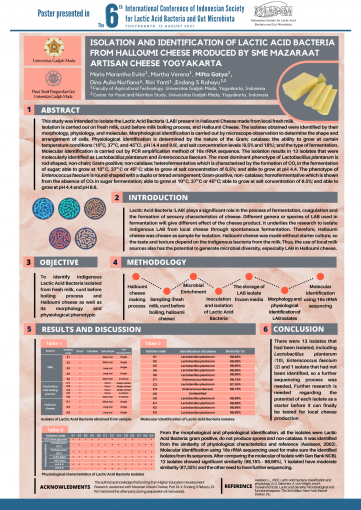
By: Maria Marantha Evita, Martha Verena, Mifta Gatya, Dina Aulia Nurfiana, Rini Yanti, Endang S Rahayu
ABSTRACT
This study was intended to isolate the Lactic Acid Bacteria (LAB) present in Halloumi Cheese made from local fresh milk. Isolation is carried out on fresh milk, curd before milk boiling process, and Halloumi Cheese. The isolates obtained were identified by their morphology, physiology, and molecular. Morphological identification is carried out by microscope observation to determine the shape and arrangement of cells. Physiological identification is determined by the nature of the Gram; catalase; the ability to grow at certain temperature conditions (10 0C, 37 0C, and 45 0C), pH (4.4 and 9.6), and salt concentration levels (6.5% and 18%); and the type of fermentation. Molecular identification is carried out by PCR amplification method of 16s rRNA sequence. The isolation results in 13 isolates that were molecularly identified as Lactobacillus plantarum and Enterococcus faecium. The most dominant phenotype of Lactobacillus plantarum is rod-shaped, non-chain; Gram-positive; non-catalase; heterofermentative which is characterized by the formation of CO2 in the fermentation of sugar; able to grow at 10 0C, 37 0C or 45 0C; able to grow at salt concentration of 6.5%; and able to grow at pH 4.4. The phenotype of Enterococcus faecium is round-shaped with a duplo or tetrad arrangement; Gram-positive, non-catalase; homofermentative which is shown from the absence of CO2 in sugar fermentation; able to grow at 10 0C, 37 0C or 45 0C; able to grow at salt concentration of 6.5%; and able to grow at pH 4.4 and pH 9.6.
Keywords: halloumi cheese, fermentation, lactic acid bacteria, curd, milk
*This poster was presented in The 6th International Conference of Indonesian Society for Lactic Acid Bacteria and Gut Microbiota (6th ISLAB) on 13th August 2021
More information about the poster -> Click here
More information about the event -> Click here
